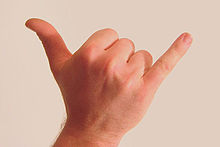Shaka sign
This article needs additional citations for verification. (August 2007) |

The shaka sign is a common greeting gesture. It is often associated with Hawaii. It consists of extending the thumb and smallest finger while keeping the three middle fingers curled, and raising the hand as in salutation with the back of the hand facing the person that is being greeted; sometimes the hand is rotated back and forth to emphasize the sign.
The "shaka sign" has its roots in the Hawaiian custom of holding a lei (a necklace made of flowers) for the purpose of placement over the head on the shoulders of another in an Aloha greeting. The three middle fingers grasp the lei from over the top while the thumb and small finger rest under the lei thus spreading the 'necklace' open.[citation needed]
Meaning and use
Hawaiian locals use the shaka to convey what they call the "Aloha Spirit", a gesture of friendship and understanding between the various ethnic cultures that reside within Hawaii, and thus it does not have a direct semantic to literal translation. Depending on context it can also be used to communicate notions such as "thank you", "hi", "howzit", and the like. The shaka gets a lot of use on the roads as an effective drivers sign language and in photographs to a communicate a distant greeting.
Residents of states other than Hawaii who use the shaka may describe it as meaning "hang loose", and in Florida the symbol itself is more commonly called the "hang loose" sign rather than the shaka sign. It can also be used to signal "hello", "goodbye", "till next time", "take care" or "all right!". In sign language, the shaka is one of the two signs used to refer to surfing.[citation needed]
In California, the Shaka sign is referred to as the "chill" or "hang ten" sign. It enjoys widespread use throughout the state and serves as an important cultural symbol.
In the east coast of Brazil, the shaka sign is known only as the "hang loose" sign and is one of the most popular gestures.[1]
In the Caribbean, mostly in the Lesser Antilles Aruba, Bonaire & Curaçao it's used as a form of "sex" if used in the way of the thumb facing yourself and the pinkie facing in front and moving it towards the person and yourself.[citation needed]
In China, this gesture also means "6". [2]
Origin

One theory according to the Honolulu Star-Bulletin,[3] prevailing local lore credited the gesture to Hamana Kalili of Laie, who lost the three middle fingers of his right hand while working at the Kahuku Sugar Mill. Kalili was then shifted to guarding the sugar train, and his all-clear wave of thumb and pinkie is said to have evolved over the years into the shaka as children would imitate his unique hand "waaaave."[4]
The shaka sign was popularized among locals in Hawaii through its use by surfers and in surf culture throughout the state in the 1960s. It was adopted as a salutation of friendship by the local culture at large from then on.[citation needed]
References
- ^ http://caminbrazilandbolivia.blogspot.com/2010/09/brazil-and-i-celebrate-our-two-month.html
- ^ Chinese number gestures
- ^ Watanabe, June (31 March 2002). "Wherever it came from, shaka sign part of Hawaii". Honolulu Star-Bulletin. Retrieved 13 January 2011.
- ^ "The Shaka". Polynesian Cultural Center. Retrieved 13 January 2011.
